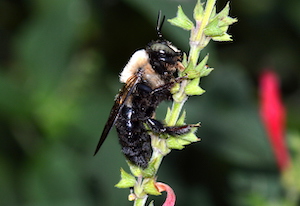
By Terry W. Johnson
Until I retired, I never spent much time watching bumblebees. I guess, like most folks, I took them for granted.
Nowadays, with more time on my hands, the flight of a bumblebee never fails to grab my attention. My observations of bumblebees visiting flowers in my backyard, coupled with learning more about them, has transformed me into a great admirer of these large, hairy insects.
Forty-nine species of bumblebees are native to North America. Seventeen of them reside in Georgia. One of the first things I noticed about these flying insects is that they are extremely industrious. They can be seen before many trees have even leafed out in March, and are still around seven months later in October when the leaves are changing color in October.
During this time, they begin visiting flowers early in the morning, long before most other wild pollinators are flying. At the close of the day, they are still hard at work long, after other insects have settled in for the night. During their extended workday, they visit more flowers and collect more pollen and nectar than other insects.
According to U.S. Forest Service research ecologist Joseph O'Brien, "Bumblebees are extremely efficient pollinators. In the time it takes for a honeybee to pollinate a single blueberry flower, a bumblebee can pollinate as many as six."
In order to work this hard, bumblebees have an extremely high rate of metabolism. The hummingbird's metabolism rate is considered one of the highest of any warm-blooded animal. However, it is nothing compared to that of the bumblebee. Entomologists tell us the bumblebee's rate of metabolism is 75 percent higher than the hummingbird’s.
Bumblebees also can carry heavy loads. On the average, a bumblebee returns to its nest laden with nectar and pollen amounting to roughly 25 percent of its body weight. Yet some can tote a payload of more than 75 percent of their body weight.
This is remarkable on many levels, especially when you look at their relatively small wings. We have all heard the old adage “Looks can be deceiving.” That is definitely the case with the bumblebee's wings; they appear so short you cannot help but wonder how a bumblebee can fly, let alone carry anything. The truth is that although the bee's wings are short, they are powerful and can beat 130 times a second. This rapid movement, coupled with the bee’s large body, causes the flowers of plants such as tomatoes and blueberries to vibrate and release their pollen.
Bumblebees also flap their wings differently than many other masters of the air. Instead of moving them up and down, their wings beat back and forth.
Researchers have also discovered that bumblebees do not simply visit a host of different flowers on a single foraging trip. Instead, roughly 32 percent of bumblebees will return to their hive carrying the pollen of only two kinds of flowers, while 55 percent will bring home the pollen of only one species.
Entomologists have also found that bumblebees leave a scent mark on flowers they have already visited. This proves invaluable to other bumblebees also looking for food. When they fly up to a flower that has already been visited by another bumblebee, the scent marker tells the bee not to waste its time looking for nectar and pollen, which has already been gathered. In most cases, the bee will move on to a bloom that has not been recently visited by a bumblebee.
We have all heard about honeybees performing a figure-of-eight-dance when they return to the hive. This elaborate dance tells its fellow worker bees where they can locate a great source of food. Well, it seems that bumblebees can also communicate. Although they do not perform a dance, they do rapidly fan their wings as they scoot over the honeycomb in the hive. This apparently spreads the scent of the flowers where the worker has found a good source of food. Other workers then leave the hive in search of flowers with the same aroma.
For the past few weeks, I have watched bumblebees visit the tall, pink, white and the royal purple spires of rocket larkspurs, the long, lavender and bright yellow blossoms of coreopsis, and the pink trumpet-shaped blooms of penstemon, while also noting that they visited few other blooms. I have marveled at how long and hard they toiled collecting pollen and nectar. It is obvious to me their efforts far and away exceed those of other wild pollinators.
If you take the time to watch these valuable wildlife neighbors work the flowers in your backyard, I am certain you will join the ranks of those who, like me, admire this remarkable insect.
Terry W. Johnson is a former Nongame program manager with the Wildlife Resources Division and executive director of The Environmental Resources Network, or TERN, friends group of the division’s Nongame Conservation Section. (Permission is required to reprint this column.) Learn more about TERN, see previous “Out My Backdoor” columns, read Terry’s Backyard Wildlife Connection blog and check out his latest book, “A Journey of Discovery: Monroe County Outdoors.”



















